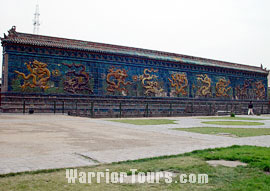- Yungang Grottoes & Wooden Pagoda
- Hanging Monastery & Mt. Hengshan
- Hukou Waterfalls
- Nine-dragon Screen & Huayan Temple
Nine-dragon Screen & Huayan Temple

The Nine-Dragon Screen in Datong is reputed to be the largest of its kind in China with a long history of over 600 years (The others are to be found in The Forbidden City and Beihai Park in Beijing). Originally built in 1392, it was the screening wall for a prince's mansion during the Ming Dynasty (1368 - 1644).
The grand screen stands eight meters high (26 feet) to the south of Heyang Jie (Heyang Street) in the city and about 45 meters (148 feet) in length. Nine color-glazed flying dragons on the screen are composed of over 400 pieces of bright-colored glazed tiles in red, yellow, peacock blue, purple, and other overtones. The middle dragon is sitting on the axis of the mansion with other eight dragons flanked in pairs on each side. On the foundation of the screen, all sorts of sacred animals are represented, including elephant, tiger, lion, deer, horse, and kylin. The screen is listed as an important provincial relic site in Shanxi Province.
| Admission Fee: | Opening Hours |
| Opening Hours: | 9:00 to 16:50 |
| Recommended Time for a Visit: | One and a half hours |
| Bus Route: | 4 |
![]() Huayan Temple
Huayan Temple
Located to the west of Datong City, Huayan Temple was one of the important temples for the Huayan Sect (one of the seven important Buddhist sects of China) during China's Liao Dynasty (916 - 1125) the sect found receptive popularity among the imperial courts. The original buildings served in part as the imperial ancestral temples but were destroyed in a fire. Rebuilt 1122 on a large scale with several extensions added during the Ming Dynasty (1368 - 1644) giving us the present complex.
 Unlike other temple architecture in China, in which the main halls and buildings are north-south axis, with the facade facing towards the south, the temple constructions in the Huayan Temple are on an east-west axis with the main halls facing to the east. This was due to the Qidan, (a minority tribe living on the northern border of China who built the Liao Dynasty,) whose tradition of praying for the Divinity of the Sun to the east, thus taking East as superior to everything.
Unlike other temple architecture in China, in which the main halls and buildings are north-south axis, with the facade facing towards the south, the temple constructions in the Huayan Temple are on an east-west axis with the main halls facing to the east. This was due to the Qidan, (a minority tribe living on the northern border of China who built the Liao Dynasty,) whose tradition of praying for the Divinity of the Sun to the east, thus taking East as superior to everything.
The temple complex is divided into two parts, namely the Upper Huayan and Lower Huayan, both of which respectively have its own mountain gate and temple layout. The Upper Huayan, featured with a range of gorgeously decorated buildings, among which, Daxiong Baodian is the main hall. With an area of 1,600 square meters (14,400 square feet), the hall stands imperially throughout ages and boasts to be one of the largest of its kind in China.

All sorts of color-clay statues of Five Buddha and twenty Buddha's warrior attendants are housed in the hall. The ceiling of the hall, intricately decorated with a variety of color-murals of dragons and phoenix, floras, Sanskrit Buddhist symbols and other geometric patterns, creates a rich visual feast for the eye. Twenty-one huge color paintings from the Qing Dynasty (1368 - 1644) on the interior wall are well preserved.
To the southeast of the Upper Huayan is its Lower counterpart, in which the Datong Museum is located. Compared to the splendid Upper Huayan, the Lower one is of a far more solemn appearance. The Sutra Preserving Hall in the latter part of the complex is where a collection of over 18,000 Buddhist sutra volumes and scripts are preserved. In addition, five finely carved wood-structured pavilions in the latter part of the hall are connected by arched bridges. These exquisite wood carved structures are the only remaining examples of their kind in China.
|
Admission Fee:
|
CNY 20 (Upper Huayan Monastery)
|
|
CNY 20 (Lower Huayan Monastery)
|
|
|
Opening Hours:
|
9:10 to 17:00
|
|
Recommended Time for a Visit:
|
One and a half hours
|
|
Bus Route:
|
Take the direct tourist bus at Datong railway station
|

